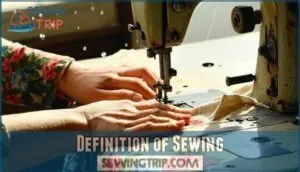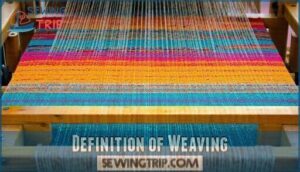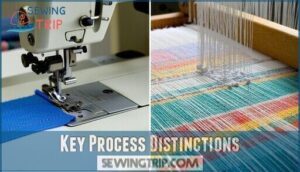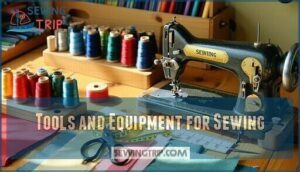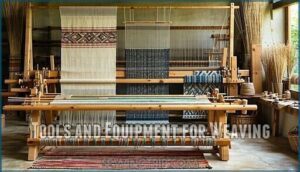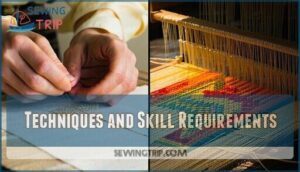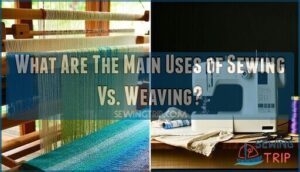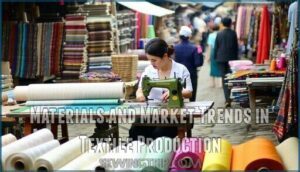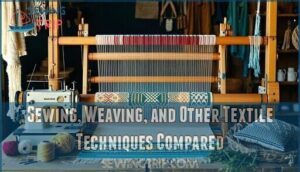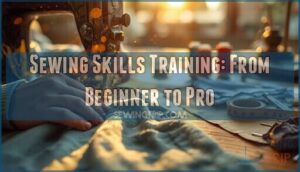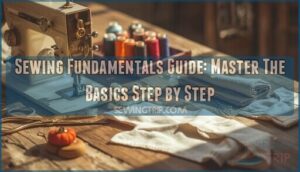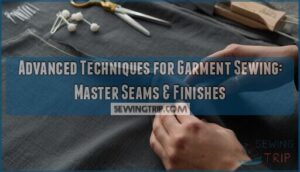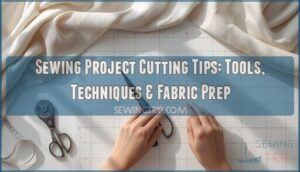This site is supported by our readers. We may earn a commission, at no cost to you, if you purchase through links.
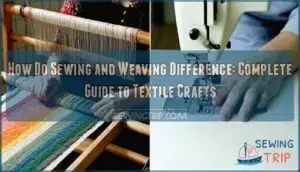
Weaving happens first to make cloth. Sewing transforms that cloth into finished items like clothes or quilts. The key difference? Weaving builds the material. Sewing shapes it into something useful.
You’ll need patience for both crafts, though each demands its own skill set. Get comfortable with thread tension and how your loom works if you’re weaving. For sewing, focus on clean stitches and following patterns accurately. Once you’ve got these fundamentals down, you can try almost anything.
Table Of Contents
Key Takeaways
- You’ll create fabric through weaving but assemble pieces through sewing – weaving interlaces threads at right angles to build the base material, while sewing joins pre-made fabrics together using needle and thread.
- You need different tools for each craft – weaving requires looms, shuttles, and yarn management systems, while sewing uses machines, needles, and various thread types for joining fabric pieces.
- You’re looking at two different skill sets – weaving demands tension management across multiple threads and loom mechanics, while sewing focuses on precise stitching techniques and fabric handling.
- You’ll find they work together in textile production – weaving creates the foundation materials like cotton or wool fabrics, then sewing transforms those woven textiles into finished products like clothing and home furnishings.
What is The Difference Between Sewing and Weaving?
When you’re working with textiles, you’ll quickly notice that sewing and weaving are completely different processes. Sewing joins pieces of fabric together using a needle and thread, while weaving creates the actual fabric by crossing threads at right angles.
Definition of Sewing
Sewing transforms fabric pieces into finished items using needle and thread. You’ll join materials through stitching techniques that create permanent bonds. This craft lets you repair, alter, or construct textiles with precision.
Here are five essential sewing basics you need to master:
- Thread Types – Choose cotton for natural fabrics, polyester for synthetics, and silk for delicate materials
- Fabric Selection – Match your material to your project’s durability and care requirements
- Sewing Machines – Electric models offer speed and consistency for most projects
- Stitch Patterns – Master straight, zigzag, and buttonhole stitches for varied applications
- Needle Selection – Use sharp points for woven fabrics, ballpoint for knits
Definition of Weaving
Through the magic of interlacing, weaving creates fabric by crossing threads at right angles. You’ll work with warp threads (vertical) and weft threads (horizontal) on a loom. This ancient craft transforms individual yarns into sturdy textiles through systematic thread patterns.
| Component | Function | Example |
|---|---|---|
| Warp | Vertical threads | Cotton base |
| Weft | Horizontal threads | Wool accent |
| Loom | Framework tool | Table loom |
| Pattern | Thread arrangement | Plain weave |
Yarn selection and loom mechanics determine your fabric’s final properties and appearance.
Key Process Distinctions
These crafts operate in completely different ways. Sewing and weaving might both use thread, but that’s where the similarities end.
Fabric formation happens during weaving through interlacing threads at right angles. Sewing techniques join pre-made materials together. Thread tension matters in both, but weave structures create the base fabric while stitch patterns assemble pieces.
Material selection affects each differently—weavers choose fibers, sewers pick fabrics.
How Are Sewing and Weaving Performed?
The tools for sewing and weaving couldn’t be more different. While sewing uses needles and thread to stitch fabric pieces together, weaving actually creates the fabric by interlacing threads on a loom.
Tools and Equipment for Sewing
Essential tools turn fabric dreams into reality. You’ll need a sewing machine for speed and precision. The needle creates each stitch. Thread holds everything together. These tools make stitching possible.
- Sewing Machines – electric models dominate with 44.8% market share
- Needle Types – universal, ballpoint, and specialty options
- Thread Selection – cotton, polyester, and silk varieties
- Fabric Cutters – rotary cutters and sharp scissors
- Sewing Notions – pins, measuring tape, and seam rippers
Tools and Equipment for Weaving
While sewing machines handle fabric joining, weaving demands different tools. You’ll need a loom to interlace warp and weft threads. Loom types range from simple frame looms to complex multi-shaft floor models. Weaving machines include rigid heddle looms for beginners. Thread management requires shuttles or bobbins. Shuttle designs vary from boat shuttles to rag shuttles. Fabric finishing tools smooth your completed cloth.
| Loom Type | Best For | Space Needed |
|---|---|---|
| Frame Loom | Tapestries | Small table |
| Rigid Heddle | Plain weave | Medium table |
| Floor Loom | Complex patterns | Large room |
| Inkle Loom | Belts/straps | Small space |
Techniques and Skill Requirements
When it comes to sewing versus weaving, you’re looking at two different craft worlds. Sewing gets you comfortable with needles, thread, and fabric – you’ll master running stitches, backstitches, and learn how different materials react to your touch.
Weaving demands managing tension across multiple threads as you create interlaced patterns on looms.
Both crafts reward you for developing steady hands and sticking with the process through those tricky learning moments.
What Are The Main Uses of Sewing Vs. Weaving?
You’ll find weaving creates the fabric itself while sewing joins pieces together. Weaving makes the cloth you wear and sewing turns that cloth into your favorite shirt.
Applications in Fashion and Apparel
Fashion design relies on both crafts working together. Weaving creates the base fabric, while sewing transforms it into wearable art. You’ll find apparel production uses pre-woven materials for garment construction. Clothing manufacturing combines both techniques, and textile innovation drives the apparel industry forward.
| Weaving Role | Sewing Role |
|---|---|
| Creates fabric foundation | Assembles garment pieces |
| Determines fabric properties | Adds fit and function |
| Sets textile structure | Facilitates design details |
| Produces raw materials | Completes final products |
Home Furnishings and Industrial Uses
Your home needs both woven fabrics and sewn finishes. Weaving creates the base textiles for curtains and upholstery. Sewing assembles these materials into finished products. Industrial textiles rely on weaving for strength. Furniture manufacturing combines both processes for durability.
| Application | Weaving Role | Sewing Role |
|---|---|---|
| Curtains | Fabric creation from threads | Hemming and hanging loops |
| Upholstery | Base textile production | Covering furniture frames |
| Carpets | Interlacing fibers for durability | Binding edges and seams |
| Bedding | Sheet and pillowcase fabric | Assembling covers and closures |
| Industrial covers | Heavy-duty fabric production | Custom fitting and reinforcement |
Textile Art and Decorative Purposes
Beyond practical uses, both techniques shine as artistic expressions. You can create stunning wall hangings through tapestry weaving or transform plain fabric into masterpieces with decorative embroidery. Art quilting combines both skills beautifully.
| Weaving Arts | Sewing Arts |
|---|---|
| Tapestry Weaving | Art Quilting |
| Fabric Design | Decorative Embroidery |
| Textile Patterns | Fabric Creation |
| Traditional Textiles | Modern Textile Arts |
These crafts let you explore endless creative possibilities while preserving traditional skills.
Materials and Market Trends in Textile Production
You’ll work with materials that shape both your craft choices and your budget. Cotton and polyester prices jumped 8-10% in 2024, while the global textile market reached $1.11 trillion with Asia Pacific leading at nearly 50% market share.
Common Materials Used in Sewing and Weaving
You’ll work with three main fabric types when sewing and weaving. Cotton stands as the workhorse material. It’s affordable and forgiving for beginners. Cotton blends mix natural fibers with synthetic fibers for durability. Silk brings luxury but demands careful handling. Wool offers warmth and structure but can shrink.
Thread selection matters just as much as fabric choice. Quality thread prevents breaking mid-project. Synthetic fibers like polyester resist fading and stretching.
Yarn quality affects your weaving results directly. Poor yarn creates weak fabric. Good yarn creates lasting textiles. Match your materials to your project’s purpose.
Regional Contributions and Market Share
Where does your fabric come from? Asia Market Trends show the region controls nearly half of the Global Textile Share. Asia-Pacific dominates with 48.7% of worldwide textile manufacturing. China leads Regional Fiber Production alongside India and Southeast Asia. Cotton Price Impact affects every region differently. North America holds 23% of industrial fabric production. Europe captures 20% with a premium focus. These Textile Export Strategies shape global supply chains. The textile industry’s global market trends are vital for understanding fabric production.
- Asia-Pacific leads with $90 billion woven fabric market, growing to $120 billion by 2032
- North America’s textile market reached $45 billion, driven by high-performance fabric demand
- Europe focuses on sustainable Fabric Manufacturing Processes worth $52 billion by 2032
- Latin America contributes 9% through Brazil and Mexico’s Garment creation hubs
- Africa shows +18% growth in Textile Production Techniques, outpacing other regions
Sewing, Weaving, and Other Textile Techniques Compared
Different textile techniques serve unique roles in your crafting arsenal.
We’ll compare weaving, knitting, embroidery, and sewing to help you pick the right method for any fabric work you want to create.
Weaving Vs. Embroidery Vs. Knitting
Each textile technique creates different results. Weaving forms fabric by crossing threads at right angles. Knitting loops yarn types together to create stretchy materials. Thread counts matter most in weaving.
Embroidery adds decorative stitches to existing fabric patterns. Fiber blends work well for embroidery projects.
These design principles tie everything together across weaving, knitting, and embroidery. Each technique has its own sweet spot in the crafting world.
Choosing The Right Technique for Your Project
Your Project Planning starts with matching technique to goal. Consider fabric selection first. Will you sew existing fabric or weave new material? Here’s your roadmap:
- Fabric needs: Sew for repairs, alterations, garments
- Thread types: Match weight to project complexity
- Time frame: Weaving patterns take longer than stitching
- Equipment: Sewing machines work faster than hand weaving
- Skill level: Start simple, advance gradually
Choose based on your vision, not tradition.
Future Outlook for Textile Crafts and Manufacturing
Automation is reshaping textile crafts forever. You’ll see digital printing transform fabric production while sustainable fabrics dominate manufacturing trends. Eco-friendly materials will replace traditional options as textile innovation drives change.
Weaving and sewing will blend with smart technology. Robots will handle repetitive tasks, allowing artisans to focus on creative design work. This shift preserves traditional skills while embracing modern efficiency in textile items.
The industry is adopting sustainable manufacturing practices to reduce waste.
Frequently Asked Questions (FAQs)
Can knitting be considered a form of sewing or weaving?
Knitting isn’t sewing or weaving. You’re creating fabric by interlocking loops of yarn with needles.
Weaving crosses threads at right angles. Sewing joins existing fabrics together. Knitting makes its own unique textile structure.
Can beginners learn sewing or weaving faster?
You’ll pick up sewing faster than weaving. Sewing uses simple straight stitches you can master quickly. Weaving requires learning complex thread patterns and loom setup that takes more time.
Which technique requires more expensive startup costs?
Weaving will hit your wallet harder than sewing right out of the gate. You’ll need a loom, which starts around $200-500 for basic models, plus specialized threads and shuttles.
Sewing requires just a machine ($100-300), needles, and thread to get started.
How long does each process typically take?
Sewing time depends on your project’s complexity. You’ll finish simple repairs in minutes, while intricate garments take hours or days.
Weaving requires more patience—basic fabric takes several hours, complex patterns need weeks of steady work.
Are there health risks with sewing machines?
Yes, you can face needle punctures to fingers, electrical shocks from worn cords, repetitive strain injuries, and eye hazards from broken needles.
Keep fingers away from moving parts and take frequent breaks.
What career opportunities exist in each field?
Countless doors open when you master these textile arts! You’ll find work as fashion designers, textile artists, patternmakers, or production operators.
Popular paths include fashion designer, seamstress, patternmaker, and alterations specialist in sewing. Weaving offers loom operator roles.
Conclusion
These textile crafts open up a world of creative possibilities. When you understand how sewing and weaving work together, you’ll see opportunities everywhere. Weaving gives you the raw materials – the fabric itself. Sewing takes those materials and turns them into something useful and beautiful.
Weaving creates fabric from threads while sewing transforms that fabric into finished products—two complementary crafts that work together to build the textile world around us
Start small to build your confidence. Simple projects teach you the fundamentals without overwhelming you. Regular practice develops the steady hands you need. Both crafts reward patience with results that genuinely impress.
Whether you stick with time-tested methods or explore modern approaches, you’re joining a long line of craftspeople who’ve shaped how we think about textiles.
- https://design-encyclopedia.com/?T=Stitch+Vs+Weave
- https://www.grandviewresearch.com/industry-analysis/textile-market
- https://straitsresearch.com/report/industrial-sewing-machine-market/united-states
- https://www.tendata.com/blogs/tradedata/10049.html
- https://textileexchange.org/knowledge-center/reports/materials-market-report-2024/

